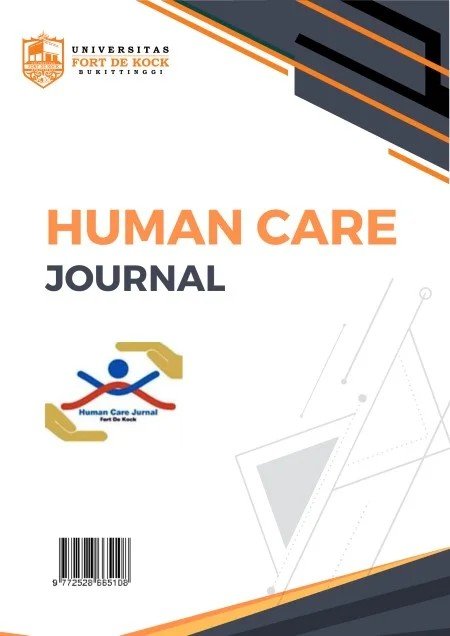FAKTOR RESIKO KEJADIAN TUBERKULOSIS PARU DI WILAYAH KERJA PUSKESMAS TIAKAR KOTA PAYAKUMBUH
DOI:
https://doi.org/10.32883/hcj.v9i1.2905Abstract
Tuberculosis disease is an infectious disease caused by Mycobacterium Tuberculosis and pulmonary TB disease is still a public health problem that needs to be watched out for. The number of new TB cases in Indonesia in 2019 was 845.000 cases and in West Sumatra, Payakumbuh City was in the top five with 180 cases and Tiakar Community Health Center was in the third highest number of TB cases in Payakumbuh City in 2020. The purpose of study was to determine the risk factors for pulmonary tuberculosis in the working area of the Tikar Public Health Center, Payakumbuh City. This research method is observational analytic with case control study design. The sample amounted to 62 consisting of 31 case samples and 31 control samples. Primary data was collected using a questionnaire and analyzed by univariate and bivariate with chi-square test. The results of the study show that the risk factors associated with pulmonary TB disease are the habit of defecating indiscriminately (p -value 0.002 and OR 3.870), smoking habit (p-value 0.001 and OR 0.139), habit of opening windows (p-value 0.000 and OR 14.950), and occupancy density (p-value 0.000 and OR 11.979). The conclusion is that the habit of excreting phlegm carelessly, smoking habits, the habit of opening windows, and residential density are risk factors associated with tuberculosis. It is recommended to the public to apply more healthy living behavior and increase awareness by paying attention to the factors that cause pulmonary TB.
References
Anies. (2006). Manajemen Berbasis Lingkungan Solusi Mencegah dan Menanggulangi Penyakit Menular. Jakarta: Elex Media Komputindo.
Carolus, S. (2017). Tuberkulosis Bisa Disembuhkan. Jakarta: Gramedia.
Dinas Kesehatan Kota Payakumbuh. (2020). Profil Kesehatan Kota Payakumbuh Tahun 2020.
Dinas Kesehatan Provinsi Sumbar. (2018). Profil Kesehatan Dinas Kesehatan Provinsi Sumatera Barat Tahun 2018.
Halim, & Budi, S. (2017). Faktor yang Berhubungan dengan Kejadian TB Paru di Puskesmas Sempor I Kebumen. Jurnal Kesmas Jambi (JKMJ), 1(1).
Kemenkes. (2011). Pedoman Nasional Pengendalian Tuberkulosis. Kemeterian Kesehatan RI.
Kemenkes. (2018). Pusat Data dan Informasi Tuberkulosis.
Lahabama, J. (2011). Hubungan Kepadatan Hunian Rumah Terhadap Penularan Tuberkulosis Paru di Kota Pontianak. Universitas Tanjungpura Pontianak.
Lalombo, A. Y., Palandeng, H., & Kallo, V. (2015). Hubungan Kebiasaan Merokok dengan Kejadian Tuberkulosis Paru di Puskesmas Siloam Kecamatan Tamako Kabupaten Sangihe. Jurnal Keperawatan, 3(2). https://doi.org/https://doi.org/10.35790/jkp.v3i2.7529
Notoatmodjo, S. (2012). Metodologi Penelitian Kesehatan. Jakarta: Rineka Cipta.
Nurhanah, Amiruddin, R., & Abdullah, T. (2010). Faktor-Faktor yang Berhubungan dengan Kejadian Tuberkulosis Paru Pada Masyarakat di Provinsi Sulawesi Selatan 2007. Jurnal MKMI, 6(4), 204–209. https://media.neliti.com/media/publications/27384-ID-faktor-faktor-yang-berhubungan-dengan-kejadian-tuberkulosis-paru-pada-masyarakat.pdf
Puseksmas Tiakar. (2019). Laporan Tahunan Puskesmas Tiakar.
Puseksmas Tiakar. (2020). Laporan Tahunan Puskesmas Tiakar.
Tobing, T. L. (2008). Pengaruh Perilaku Penderita TB Paru dan Kondisi Sanitasi Terhadap Pencegahan Potensi Penularan TB Paru pada Keluarga di Kabupaten Tapanuli Utara. Universitas Sumatera Utara.
WHO. (2018). Global Tuberculosis Report. Geneva: WHO.
WHO. (2020). Global Tuberculosis Report. Geneva: WHO.
Yigibalom. (2019). Faktor Resiko Kebiasaan di Rumah Etnis dan Membuang Dahak Sembarangan dengan Kejadian TB Paru. UNDIP.
Yunus. (2018). Faktor Resiko Yang berhubungan dengan kejadian TB Paru. Universitas Hasanuddin.
Downloads
Published
How to Cite
Issue
Section
License
Copyright (c) 2025 Human Care Journal

This work is licensed under a Creative Commons Attribution 4.0 International License.
Setiap naskah yang terbit di jurnal Human Care ini adalah dianggap sebagai karya dari penulis.
Pemegang hak cipta adalah jurnal Human Care. Semua pembaca memiliki akses untuk masuk ke jurnal Human Care dan menjadikan naskah yang terbit di jurnal Human Care sebagai referensi.



